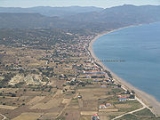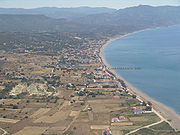
Vatera
Encyclopedia

Beach
A beach is a geological landform along the shoreline of an ocean, sea, lake or river. It usually consists of loose particles which are often composed of rock, such as sand, gravel, shingle, pebbles or cobblestones...
in the southern part of Lesbos
Lesbos Island
Lesbos is a Greek island located in the northeastern Aegean Sea. It has an area of with 320 kilometres of coastline, making it the third largest Greek island. It is separated from Turkey by the narrow Mytilini Strait....
island. The name (Βατερά) comes from βάτα (vata
Vata
Vata may refer to:*Vāta, another name for Vāyu*A particular Zoroastrian divinity, one half of the pair Vata-Vayu*Vata , one of the three dosha in Ayurveda, ancient Hindu science of health and medicine* Vata, Sanskrit word for the Banyan tree....
): prickly bushes that blocked the old mule-drive access.
It is 55Km in total from Mytilini. The 7Km long, sandy beach here, backed by vegetated hills and looking out to Hios and Psara
Psara
Psara is a Greek island in the Aegean Sea. Together with the small uninhabited island of Antipsara it forms the municipality of Psara. It is part of the Chios peripheral unit, which is part of the North Aegean Periphery. The only town of the island and seat of the municipality is also called...
, offers some of the warmest, cleanest swimming on Lesvos. Several family hotels and taverns with traditional tastes are across the biggest beach on the island.
3Km west you can gaze out to the cape of Agios Fokas, where foundations and columns stubs remain of the temple of Dionysos and an early Christian
Christian
A Christian is a person who adheres to Christianity, an Abrahamic, monotheistic religion based on the life and teachings of Jesus of Nazareth as recorded in the Canonical gospels and the letters of the New Testament...
basilica
Basilica
The Latin word basilica , was originally used to describe a Roman public building, usually located in the forum of a Roman town. Public basilicas began to appear in Hellenistic cities in the 2nd century BC.The term was also applied to buildings used for religious purposes...
.
The Vatera area hit the Greek news in 1997 when a palaeontologist, Michael Dermitzakis, confirmed what farmers unearthing bones had long suspected when he announced that the area was a treasure trove of two-million-year old fossil
Fossil
Fossils are the preserved remains or traces of animals , plants, and other organisms from the remote past...
s, belonging to the Late Pliocene
Pliocene
The Pliocene Epoch is the period in the geologic timescale that extends from 5.332 million to 2.588 million years before present. It is the second and youngest epoch of the Neogene Period in the Cenozoic Era. The Pliocene follows the Miocene Epoch and is followed by the Pleistocene Epoch...
. The fossils include bones of stenoid horses (Equus
Equus (genus)
Equus is a genus of animals in the family Equidae that includes horses, donkeys, and zebras. Within Equidae, Equus is the only extant genus. Like Equidae more broadly, Equus has numerous extinct species known only from fossils. This article deals primarily with the extant species.The term equine...
stenonis), mastodons, a baboon-like monkey (Paradolichopithecus) and a giant tortoise (Cheirogaster), the latter the size of a small car.
Around two million years ago, Lesvos was not an island but was joined to the Asian mainland, and the gulf of Vatera was a subtropical shallow sea. The environment of Vatera at that time, was partly forested, partly open woodlands, with meandering rivers through the area flowing to the sea. The animals in question died somewhere near the rivers and their carcasses were transported by the water downstream. They got stuck somewhere at a bend, and sediments covered the remains until they were removed by Dermitzakis' team. In the nearby village of Vrissa
Vrissa
Vrisa is a village in the southern part of Lesbos island approximately 50 km from Mytilene. The village is named after one of the two girls Agamemnon took from Lesbos during the ten-year Trojan War. Five kilometers south is the famous Vatera beach....
, the University of Athens has established a Natural history collection dedicated to the pale ontological finds.
See also
- Communities of the Lesbos prefecture

